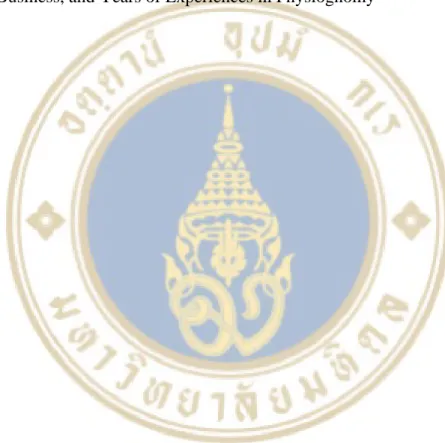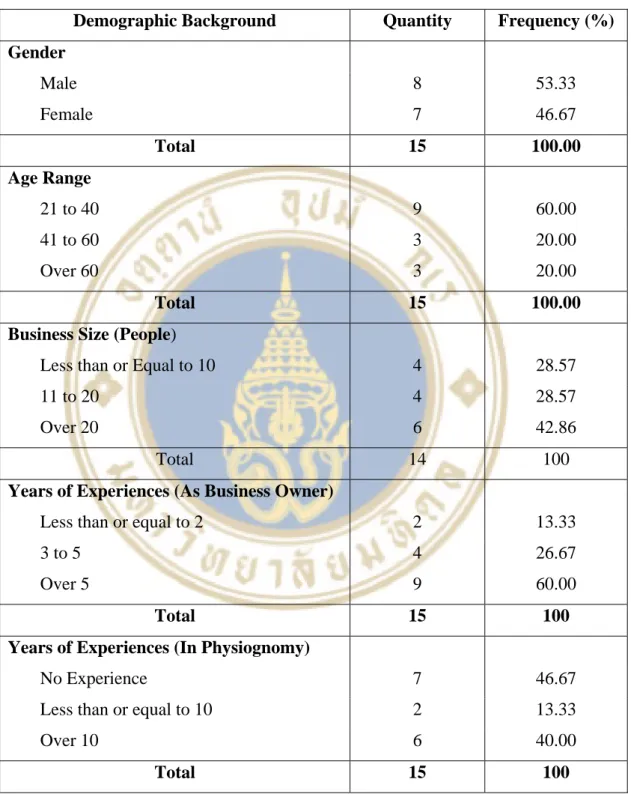Therefore, the purpose of this research is to discover the meaning of the application of physiognomy in the organization, and to introduce physiognomy as one of the tools of human resource management. If the recruitment decision went wrong, the situations after making a wrong hiring decision can lead to the bad future of the company. We can train people on technical skills, but it's really hard to teach things like compassion and understanding". (Katz, 2015 P.1) The phrase highlighted the importance of finding competencies as much as credentials in recruiting. .
The HRM of Thai SMEs was once described: "The lack of employee evaluations shows that Thai SMEs have a relatively casual attitude towards their employees, as they do not care about objectively identifying better employees."

An impact of Ineffective HRM in Thai SMEs
The lack of a clear job description also means that the company may not be able to assess employee performance. There are prices the company must pay for hiring unqualified workers and matching them with the wrong tasks.
Physiognomy in the Nutshell
And the company may not realize that they are keeping employees with low performance and productivity for too long, when in fact they need to terminate them for the company's benefits. These costs will be included in the company's results, which can define the company's financial status.
Applying Physiognomy in Human Resource Management
A good physiognomist can read people's face as if it were their autobiography, tell people's future by looking at how they walk. This is why the concept of reading people's facial features has also been applied in business, especially in labor recruitment. Although physiognomy is in the midst of debate as to whether it is considered pseudoscience or just another type of fortune telling, like Feng Shui, this unproven art form of face reading has survived for millennia and is still commonly used in global societies.
The concept of physiognomy is actually already implemented in modern HRM. In addition to looking for the skills, knowledge, abilities and experience required of candidates, during the interview companies also look for personality that matches the requirements of the job, attractiveness or ability to impress the candidates, how they carry themselves, talk, walk and make eye contact. In addition to overall appearance reading, there are three ways of reading people's face and appearance that can be used in the HRM aspect, i.e. facial structure, facial features, age parts1.
In addition, facial features can also tell about all aspects of people's lives, which are family, wealth, work, health and subordinates. Physiognomy believes that if we divide the human face into 3 parts, each part can tell us about the person's life in early age, middle age and late age. Usually, people's working life is in middle age, so if a person in middle age is standing out from his/her face, you can assume that he/she may have a successful professional life.
RESEARCH METHODOLOGY
Population and Sampling
Data Collection & Sample Interview Questions
Business owners who have experience in practicing physiognomy: The questions are designed to define their knowledge of physiognomy, the implementation of physiognomy in personnel management in the company and their attitude towards physiognomy in modern society. Business owners who have HRM problems in the organization: The questions are designed to learn about their HRM problems and their current solution, their willingness and interest in a new tool in HRM and their attitude towards physiognomy in general.
Data Analysis
Professional physiotherapist with a high knowledge of physiognomy: the questions aim to explore how to understand the implication of physiognomy, and the possibility of applying physiognomy in modern business HRM, such as:. However, within this study, only levels 1 and 2 of coding are sufficient to conduct data analysis. If terms or words are mentioned by many interviewees at level 1, the researchers will focus more on those words and terms during data analysis.
By observing the words or phrases that are frequently mentioned in the interview, the research will be able to indicate the keywords that can be useful in the data analysis. When the interviewees used metaphors to describe something, it could show their beliefs or their thinking pattern. Narrative analysis is the analysis of data obtained from storytelling, which can be performed through 4 different approaches, how the story was told, how the story was structured, how the story was co-constructed, and the use of visualization to complete the story . Sites.harvard.edu, 2008).
In addition, narratives fit some research topics, such as sensitive topics, where informants can express their views and experiences about the matter in their own words at their own pace, usually in a good atmosphere.” Aarikka-Stenroos, 2010, p. 18) With these supports, the researcher believes that narrative analysis can be used as one of the coding strategies for this research topic.
FINDINGS AND DISCUSSION
Demographic Profiles of Respondents
Research Findings
- An Expert Point of View
- Comparison between 2 Business Generations
- Worst HRM Issue and the Need for Physiognomy
As previously mentioned in the previous chapter, human resource management is one of the biggest challenges of any business. This is why having the right person with the right competencies in the environment is so essential. The information collected for the second group of respondents, the 2 generations of business owners aims to determine the differences in the application of physiognomy between running a business in the present time and running a business in the past.
2 out of 3 claimed that they were the only person in the generation to whom their parents passed on the knowledge of physiognomy, which was the only way they could earn their knowledge of physiognomy in their time. 3 of them agree that the access to the physiognomy knowledge was very limited in the past and was reserved only among members of the family or community. It is very difficult for ordinary people to acquire knowledge of physiognomy without the connection or having experienced someone in the family.
The statement shows that in the previous generation, for small businesses, the concept of CV and interview was not widely introduced, and it was difficult to get the reference of the individual who applied for the job. The interview showed that even though the old generation believes in the accuracy and effectiveness of physiognomy, they think that physiognomy is a dated and dying science that is no longer necessary for modern society. This can lead to everyone in the organization not doing their jobs efficiently, and lowers the organization's productivity as a whole.
RECOMMENDATIONS
Introducing Physiognomy as an HRM Tool
Physiognomy should be introduced on a general basis into the category of HRM tools, such as CVs, interviews and work samples, with the clear responsibility of each tool, CVs for KSAs, interviews and work samples for competencies and organizational fit, and physiognomy is for internal factors or an individual's true self. Highlighting the importance of physiognomy as one of the HRM tools will impact both the old and new business generations. The old generation will realize that they and their knowledge are still needed so that they can pass on what they have learned throughout their lives to the next generation.
The new generation will see physiognomy as a new essential HRM tool to learn so that they can manage their human resources in the organization.
Gaining Knowledge and Practice of Physiognomy
The second recommended practice is for companies with larger sizes and more systematic functions. For a better example, this is the company with a clearer level of hierarchy, where there is a management level between the owner and the general workforce. The owner must be trained and have a deeper knowledge of physiognomy to select the managers who will work directly under the owner and protect the company's profits.
This practice can consume more in financial terms because more people had to be trained and there is a possibility that managers will leave the company with knowledge and new training costs will arise to train a new manager. The final best practice for organizational physiognomy is to seek professional advice or to hire a physiognomy specialist for the company, not as a full-time employee, but owners can ask for their opinion when the company hires new employees. IT can be used in all sizes of companies that match the company with no physical experience and do not want to waste time on training.
There may be someone who wants to take the opportunity for granted and make a profit from the company's needs. A company may need to do a lot of research before deciding which physiognomist the organization should use. It may be much cheaper for a company to organize training for employees than to hire a physiognomist.
Research Limitations & Recommendations
Retrieved from https://books.google.co.th/books?id=BPzCCAAAQBAJ&pg=PT7&lpg=P T7&dq=face+reading+an+oriental+culture&source=bl&ots=PXwtVuKda N&sig=l2jh3_m28gtoSsakCXwF= Q6A EwAWoVChMI0bGY1ZqcyAIVUxuOCh08lQKg#v =onepage&q=face %2 0reading%20an%20oriental%20culture&f=false. Retrieved from https://books.google.co.th/books?id=_9R2Bg AAQBAJ&pg=PA105&lpg=PA105&dq=qualitative+research+interview+r eflective+note+taking&source=bl&ots=FDm01EI9na6y5HBexgus hl=en&sa=X&ved=0CFoQ6AEwCWoVChMI - afh2rm0yAIVDE -OCh0exQ1k#v=onepage&q=quality%20 searches%.
APPENDICES
Appendix A: Physiognomy Method Related to HRM – Face Structure
Appendix B: Physiognomy Method Related to HRM – Facial Features
Appendix C: Physiognomy Method Related to HRM – Age Sections
Appendix D: Physiognomy Expert Biography
Appendix E: The Interview Guide
Physiognomy Expert
Business Owners with Physiognomy Experiences
Business Owners with HRM Issues in the organization
